
HMS Indomitable was one of three Invincible-class battlecruisers built for the Royal Navy before World War I and had an active career during the war. She tried to hunt down the German ships Goeben and Breslau in the Mediterranean when war broke out and bombarded Turkish fortifications protecting the Dardanelles even before the British declared war on Turkey. She helped to sink the German armoured cruiser Blücher during the Battle of Dogger Bank in 1915 and towed the damaged British battlecruiser HMS Lion to safety after the battle. She damaged the German battlecruisers Seydlitz and Derfflinger during the Battle of Jutland in mid-1916 and watched her sister ship HMS Invincible explode. Deemed obsolete after the war, she was sold for scrap in 1921.

HMS Queen Elizabeth was the lead ship of her class of five dreadnought battleships built for the Royal Navy in the early 1910s, and was often used as a flagship. She served in the First World War as part of the Grand Fleet, and participated in the inconclusive action of 19 August 1916. Her service during the war generally consisted of routine patrols and training in the North Sea. She and the other super-dreadnought battleships were the first of their type to be powered by oil instead of coal. Queen Elizabeth later served in several theatres during the Second World War, and was scrapped in 1948.

HMS Irresistible—the fourth British Royal Navy ship of the name—was a Formidable-class pre-dreadnought battleship. The Formidable-class ships were developments of earlier British battleships, featuring the same battery of four 12-inch (305 mm) guns—albeit more powerful 40-calibre versions—and top speed of 19 knots of the preceding Canopus class, while adopting heavier armour protection. The ship was laid down in April 1898, was launched in December that year, and was completed in October 1901. Commissioned in 1902, she initially served with the Mediterranean Fleet until April 1908, when she was transferred to the Channel Fleet. Now outclassed with the emergence of the dreadnought class of ships, she entered service with the Home Fleet in 1911 following a refit. In 1912, she was assigned to the 5th Battle Squadron.

HMS Raglan was a First World War Royal Navy Abercrombie-class monitor, which was sunk during the Battle of Imbros in January 1918.
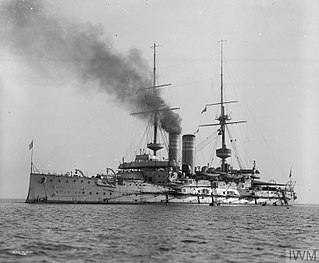
HMS Albion was a pre-dreadnought battleship of the British Royal Navy and a member of the Canopus class. Intended for service in Asia, Albion and her sister ships were smaller and faster than the preceding Majestic-class battleships, but retained the same battery of four 12-inch (305 mm) guns. She also carried thinner armour, but incorporated new Krupp steel, which was more effective than the Harvey armour used in the Majestics. Albion was laid down in December 1896, launched in June 1898, and commissioned into the fleet in June 1901.

HMS Indefatigable was the lead ship of her class of three battlecruisers built for the Royal Navy during the first decade of the 20th Century. When the First World War began, Indefatigable was serving with the 2nd Battlecruiser Squadron (BCS) in the Mediterranean, where she unsuccessfully pursued the battlecruiser Goeben and the light cruiser Breslau of the German Imperial Navy as they fled toward the Ottoman Empire. The ship bombarded Ottoman fortifications defending the Dardanelles on 3 November 1914, then, following a refit in Malta, returned to the United Kingdom in February where she rejoined the 2nd BCS.

HMS Defence was a Minotaur-class armoured cruiser built for the Royal Navy in the first decade of the 20th century, the last armoured cruiser built for the Royal Navy. She was stationed in the Mediterranean when the First World War began and participated in the pursuit of the German battlecruiser SMS Goeben and light cruiser SMS Breslau. The ship was transferred to the Grand Fleet in January 1915 and remained there for the rest of her career.

The Lord Nelson class consisted of a pair of pre-dreadnought battleships built for the Royal Navy in the first decade of the twentieth century. Although they were the last British pre-dreadnoughts, both were completed and commissioned well over a year after HMS Dreadnought had entered service in late 1906. Lord Nelson and Agamemnon were assigned to the Home Fleet when completed in 1908, with the former ship often serving as a flagship. The sister ships were transferred to the Channel Fleet when the First World War began in August 1914. They were transferred to the Mediterranean Sea in early 1915 to participate in the Dardanelles Campaign.
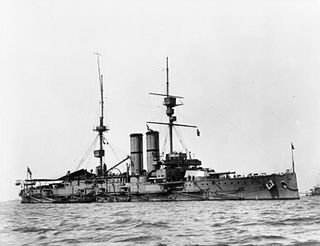
HMS Hibernia was a King Edward VII-class pre-dreadnought battleship of Britain's Royal Navy. Like all ships of the class she was named after an important part of the British Empire, namely Ireland. The ship was built by Devonport Dockyard; she was laid down in January 1904, was launched in June 1905, and was completed in December 1906. Armed with a battery of four 12-inch (305 mm) and four 9.2 in (234 mm) guns, she and her sister ships marked a significant advance in offensive power compared to earlier British battleship designs that did not carry the 9.2 in guns.
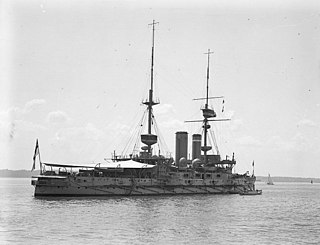
HMS Implacable was a Formidable-class battleship of the British Royal Navy, the second ship of the name. The Formidable-class ships were developments of earlier British battleships, featuring the same battery of four 12-inch (305 mm) guns—albeit more powerful 40-calibre versions—and top speed of 19 knots of the preceding Canopus class, while adopting heavier armour protection. The ship was laid down in July 1898, was launched in March 1899, and was completed in July 1901. Commissioned in September 1901, she was assigned to the Mediterranean Fleet and served with the fleet until 1908. After a refit, she transferred to the Channel Fleet, then onto the Atlantic Fleet in May 1909. By now rendered obsolete by the emergence of the dreadnought class ships, she was assigned to the 5th Battle Squadron and attached to the Home Fleet in 1912.

HMS Lord Nelson was a Lord Nelson-class pre-dreadnought battleship launched in 1906 and completed in 1908. She was the Royal Navy's last pre-dreadnought. The ship was flagship of the Channel Fleet when the First World War began in 1914. Lord Nelson was transferred to the Mediterranean Sea in early 1915 to participate in the Dardanelles Campaign. She remained there, becoming flagship of the Eastern Mediterranean Squadron, which was later redesignated the Aegean Squadron. After the Ottoman surrender in 1918 the ship moved to the Black Sea where she remained as flagship before returning to the United Kingdom in May 1919. Lord Nelson was placed into reserve upon her arrival and sold for scrap in June 1920.

HMS Cornwallis was a Duncan-class pre-dreadnought battleship of the Royal Navy. Built to counter a group of fast Russian battleships, Cornwallis and her sister ships were capable of steaming at 19 knots, making them the fastest battleships in the world. The Duncan-class battleships were armed with a main battery of four 12-inch (305 mm) guns and they were broadly similar to the London-class battleships, though of a slightly reduced displacement and thinner armour layout. As such, they reflected a development of the lighter second-class ships of the Canopus-class battleship. Cornwallis was built between her keel laying in July 1899 and her completion in February 1904.

HMS Swiftsure, originally known as Constitución, was the lead ship of the Swiftsure-class pre-dreadnought battleships. The ship was ordered by the Chilean Navy, but she was purchased by the United Kingdom as part of ending the Argentine–Chilean naval arms race. In British service, Swiftsure was initially assigned to the Home Fleet and Channel Fleets before being transferred to the Mediterranean Fleet in 1909. She rejoined Home Fleet in 1912 and was transferred to the East Indies Station in 1913, to act as its flagship.

Vérité was a pre-dreadnought battleship built for the French Navy in the mid-1900s. She was the second member of the Liberté class, which included three other vessels and was a derivative of the preceding République class, with the primary difference being the inclusion of a heavier secondary battery. Vérité carried a main battery of four 305 mm (12 in) guns, like the République, but mounted ten 194 mm (7.6 in) guns for her secondary armament in place of the 164 mm (6.5 in) guns of the earlier vessels. Like many late pre-dreadnought designs, Vérité was completed after the revolutionary British battleship HMS Dreadnought had entered service and rendered her obsolescent.
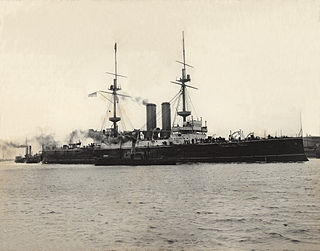
HMS Vengeance was a pre-dreadnought battleship of the British Royal Navy and a member of the Canopus class. Intended for service in Asia, Vengeance and her sister ships were smaller and faster than the preceding Majestic-class battleships, but retained the same battery of four 12-inch (305 mm) guns. She also carried thinner armour, but incorporated new Krupp steel, which was more effective than the Harvey armour used in the Majestics. Vengeance was laid down in August 1898, launched in July 1899, and commissioned into the fleet in April 1902.

HMS Exmouth was a Duncan-class pre-dreadnought battleship of the Royal Navy. Built to counter a group of fast Russian battleships, Exmouth and her sister ships were capable of steaming at 19 knots, making them the fastest battleships in the world. The Duncan-class battleships were armed with a main battery of four 12-inch (305 mm) guns and they were broadly similar to the London-class battleships, though of a slightly reduced displacement and thinner armour layout. As such, they reflected a development of the lighter second-class ships of the Canopus-class battleship. Exmouth was laid down by Laird Brothers at Birkenhead in August 1899, launched in August 1901, and completed in May 1903.

Patrie was the second and final member of the République class of pre-dreadnought battleships of the French Navy built between her keel laying in April 1902 and her commissioning in July 1907. Armed with a main battery of four 305 mm (12.0 in) guns, she was outclassed before even entering service by the revolutionary British battleship HMS Dreadnought, that had been commissioned the previous December and was armed with a battery of ten guns of the same caliber. Though built to an obsolescent design, Patrie proved to be a workhorse of the French fleet, particularly during World War I.
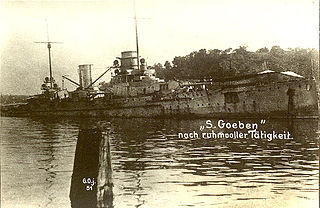
The Battle of Imbros was a naval action that took place during the First World War. The battle occurred on 20 January 1918 when an Ottoman squadron engaged a flotilla of the British Royal Navy off the island of Imbros in the Aegean Sea. A lack of heavy Allied warships in the area allowed the Ottoman battlecruiser Yavûz Sultân Selîm and light cruiser Midilli to sortie into the Mediterranean and attack the Royal Navy monitors and destroyers at Imbros before assaulting the naval base at Mudros.






















